#pubmedia
#pubmedia is the hashtag for Twits to spew 140char-acterizations of any public medium; so, OCPD sufferers (obsessive-compulsive posting disorder), opine away.
#pubmedia is the hashtag for Twits to spew 140char-acterizations of any public medium; so, OCPD sufferers (obsessive-compulsive posting disorder), opine away.
In Chapel Hill NC the family Matheny (Skip + Logan = bros, Skip + Timshel + married) formed Roman Candle.
Why Modern Radio is A-OK
Roman Candle “Why Modern Radio Is A-OK” from Lake Fever Sessions on Vimeo.
Logan: When we lived in Chapel Hill, there was about a 6-month stint where Thad Cockrell (a good friend of ours, and an amazing songwriter) was sleeping on the couch at my house. One night we had all gone over to Skip and Timshel’s for dinner. While we were cooking, we were playing various records and at some point, someone puts Neil Young’s Comes a Time on. As soon as the first song started, Thad came around the corner, genuinely teary-eyed, and said “I can’t listen to this record right now, I fell in love to that record and I’m not ready to hear it right now”. We all felt a little bad, and a couple weeks later, while Skip was brushing his teeth he came up with this song.
Don’t play Neil Young
Don’t play Van Morrison
Just let some high school emo band start versing and chorusing
Because there’s no way it will break my heart as far as I can see
and that’s why modern radio is A OK with me.
He said a pop song used to be a powerful thing,
you could turn on the a.m. and John Lennon would sing
or Frank Sinatra would be talking to all of the girls.
And you could think like a hawk or think like a dove
or think of a winter afternoon when you fell in love
and ten songs on a record sounded like a string of pearls.
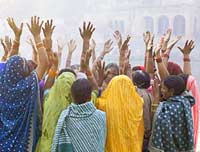
![]() Hearing Voices from NPR®
Hearing Voices from NPR®
079 Sacred Places: Maps to Heaven
Host: Alex Chadwick of Conservation Sound
Airs week of: 2011-01-12 (Originally: 2009-12-23)
“Sacred Places” (52:00 mp3):
The spirits of personal shrines and collective spaces:
Our show host maps get directions to Heaven, in the holy Hindu city of Vrindavan, India. A three story series:
“The Streets of a Holy Hindu City” are reminders that the Hindu faith is everywhere in Vrindavan — countless temples line the streets and pilgrims march in devotion. There is also stark, third-world poverty and suffering. But for the faithful, the city is a manifestation of heaven, here on Earth.
“Pilgrims on the Path of Krishna“, among the stones of ancient temples and bathing pools, march and chant praise to Krishna and his consort, Radha. They touch the holy water of the Yamuna River and walk barefoot down the same paths they believe Krishna himself once trod.
“The Embodiment of Earthly Divinity“, the focus of many worshippers in Vrindavan, is the Sri Radha Raman Temple, where a black stone statue of Krishna sits enshrined and wrapped in saffron robes. Many consider the small stone statue to be Krishna himself.
Produced by Carolyn Jensen, for Radio Expeditions, a co-production of the National Geographic Society and NPR News. The editor was Jessica Goldstein; the engineer, Flawn Williams. Photo-gallery at NPR.
Finding four places of faith around Montana: a Soiux Sundance, in a Buddhist woman’s home, a Methodist prairie church, and a sculptor’s ranch.
The producers gather sounds from the streets of their own backyard, the 112 square miles of the borough of Queens, New York, home to the largest mix of immigrants and refugees in the United States. These are people praying in different neighborhoods, in churches, mosques, synagogues, in apartments, at public gatherings and in private moments who come from Togo, China, Haiti, Nigeria, Queens, Romania, even North Carolina. Part of: Crossing the BLVD: strangers, neighbors, aliens in a new America.
The producer is in Harvard Square with his aunts, looking for a “side-room”: That’s their word for a place to pray. Five times daily, even when they’re away from home, they perform “namaaz” (nah-MAHZ), their prayer service. They find the direction of Mecca, and a space that, temporarily at least, is sacred. Hammad Ahmed’s piece, was produced for the Say It This Way podcast. A brief glossary for the uninitiated: “qibla” = the direction Muslims face while praying (i.e. towards Mecca), “namaaz” = any of the five daily prayers, “hijab” = Muslim headscarf, “sajdah” = lying prostrate during prayer, “side-room” = a private-or-not-private space that Muslims occupy for prayer when away from home.
A woman’s song on the streets of Taipei, Taiwan, leads the producer to the outskirts of town, to climb the rock steps of the White Temple. There, high in the clouds, one hundred voices are singing a salutation to the Buddha.
 For your Holiday loosening pleasure, we offer a couple hours of Chrismukkah music & mashups, an HV playlist compiled at Grooveshark. More…
For your Holiday loosening pleasure, we offer a couple hours of Chrismukkah music & mashups, an HV playlist compiled at Grooveshark. More…
 The radio program Interfaith Voices has a new series of sacred sonic features called The Soundscapes of Faith. There’s a shofar, shape singers, Sikh hymns, and several more.
The radio program Interfaith Voices has a new series of sacred sonic features called The Soundscapes of Faith. There’s a shofar, shape singers, Sikh hymns, and several more.
Check this Islamic prayer, with elaborations by Akbar Ahmed, chair of Islamic studies at American University (2:34):
One of the most beautiful sounds of Islam is the call to prayer, or adhan. It rings out in many Muslin countries 5 times a day, asking believers to pause their day and remember God.
 The NYTImes caught this canine-capitol-Chanukah connection: “Montana Rabbi Lends an Ear to an Officer and His Dog“. The article commences with this misleading lede:
The NYTImes caught this canine-capitol-Chanukah connection: “Montana Rabbi Lends an Ear to an Officer and His Dog“. The article commences with this misleading lede:
In Montana, a rabbi is an unusual sight. So when a Hasidic one walked into the State Capitol last December, with his long beard, black hat and long black coat, a police officer grabbed his bomb-sniffing German shepherd and went to ask the exotic visitor a few questions.
via Kalish.
From Trent Harris’ video travel webisode series Fling A Ding series:
FLINGADING #8: You step, you die
As a child soldier in Cambodia’s notorious Khmer Rouge army Aki Ra laid many landmines. He now clears these deadly bombs with a stick and a pocketknife, more than 10,000 to date. It is very dangerous. No one pays him to do it. Aki is the real deal.
Hearty congrats to radio producers Scott Carrier and Long Haul Productions (Elizabeth Meister & Dan Collison), recipients of this year’s United States Artists:
Chosen for the caliber and impact of their work, these exceptional artists embody our nation’s vast cultural, ethnic, and geographic diversity. Each was awarded an unrestricted grant of $50,000 in recognition of their outstanding creative contributions.

 My audio album, Fragments, is back up on iTunes — they pulled it because it violated several international treaties regulating maximum overt kewlness (or maybe it was site update glitch). Anyroad, it’s back and I kinda like the fact that in iTunes listings, I’m an Artist: Me = BG = The Wandering Jew.
My audio album, Fragments, is back up on iTunes — they pulled it because it violated several international treaties regulating maximum overt kewlness (or maybe it was site update glitch). Anyroad, it’s back and I kinda like the fact that in iTunes listings, I’m an Artist: Me = BG = The Wandering Jew.
Radio Diaries “celebrates 15 years of stories on public radio. A video retrospective hosted by Ira Glass with animation by James Blagden. Music by The Books”:
Produced by Anayansi Diaz-Cortes and Joe Richman with help from John Wong, Eric Pearse Chavez, Sue Johnson, Sara Pellegrini, Samara Freemark and Kara Oehler.
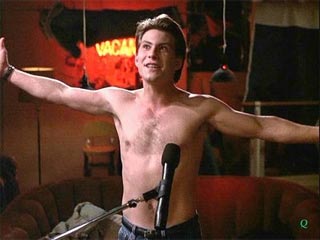 Ars Technica looks at radio’s image thru Hollywood’s lens, from Pump Up the Volume to Petey Greene to Pirate Radio, in “Radio Days: the celluloid afterlife of real radio:
Ars Technica looks at radio’s image thru Hollywood’s lens, from Pump Up the Volume to Petey Greene to Pirate Radio, in “Radio Days: the celluloid afterlife of real radio:
In the movies, radio is a mythic force: local, rebellious, life-changing. This hardly describes the reality at commercial radio stations today, but it does tell us something about how radio was — and about how we want it to be…
In Pump Up the Volume (1990), Christian Slater played Mark Hunter, a pathologically shy high school junior who morphs into “Happy Harry Hardon” at night, regaling his audience with fake masturbation stunts, Leonard Cohen tunes, and subvert-the-dominant-paradigm monologues.
“You ever get the feeling that everything in America is completely fucked up?” Hunter asks. “You know that feeling, that the whole country is, like, saying, that’s it—forget it!”
His fans agree. They bare their souls in letters sent to the post office box Harry advertises on his station, especially after he reveals that one of his classmates has been expelled for getting pregnant. Listeners send him love notes or disclose that they’re about to commit suicide. When one correspondent actually kills himself, local TV stations blame Harry for the tragedy. A witch hunt ensues. The Federal Communications Commission comes in for the carcass, only to find itself overwhelmed by copycat pirates who heed Harry’s battle cry.
“I’m calling for every kid to seize the air,” Harry pontificates from his jeep-transported radio station. “It belongs to you. Spill your guts out. Say shit and fuck a million times if you want to, but you decide! Talk on!”
Welcome to radio in the movies.
PRESENCE OF MIND
You'll conquer the present
suspiciously fast
if you smell of the future
-- and stink of the past.
—Piet Hein, More Grooks 1968
Grooks | Wikiquote | Wikipedia | Appreciation |Â Amazon
DREAM INTERPRETATION
Simplified.
Everything's either
concave or -vex,
so whatever you dream
will be something with sex
LILAC TIME
The lilacs are flowering, sweet and sublime,
with a perfume that goes to the head;
and lovers meander in prose and rhyme,
trying to say --
for the thousandth time --
what's easier done than said.
via Technology360.
XTC’s lovely, lyrical, laughable, laudable, “Dear God”:
Lyrics: More…
![]()
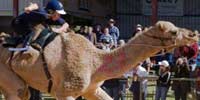 The start of this year’s camel racing season is just starting in the United Arab Eremites. In Australia the season ended a few weeks ago. Every year veteran camel trainer and jockey Glenda Sutton competes, and often wins. Photographer Tim Bonham caught up with her in Queensland, at the Boulia Camel Races.
The start of this year’s camel racing season is just starting in the United Arab Eremites. In Australia the season ended a few weeks ago. Every year veteran camel trainer and jockey Glenda Sutton competes, and often wins. Photographer Tim Bonham caught up with her in Queensland, at the Boulia Camel Races.
PRI The World is featuring a superb audio-slideshow of the event; photos and audio by producer Tim Bonham, “Camel Jockey- Glenda Sutton” (3:33 mp3):
Tim Bonham photos:
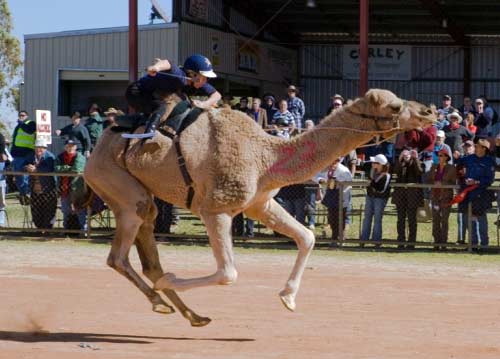
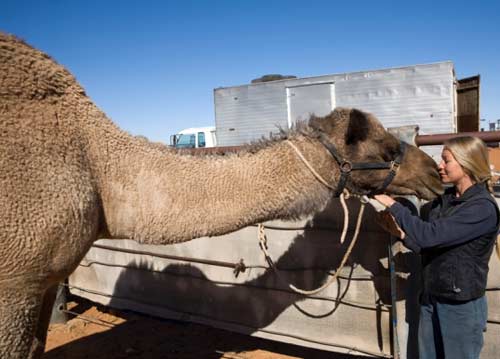

![]() Hearing Voices from NPR®
Hearing Voices from NPR®
078 Shopping for Santa: A Season’s Greeting
Host: Barrett Golding of Hearing Voices
Airs week of: 2009-12-09
“Shopping for Santa” (52:00 mp3):
Holiday spirits and communal consumption:
We go shopping at “City X,” a sound-rich history of America’s malls and their creator, architect Victor Gruen (PRX | Radio Lab | 3rd Coast).
The producer, at age 2, sings “Silent Night” with her Dad. A woman homesteader remembers brutal North Dakota winters in the 1920s. Blues legend Brownie McGhee describes homemade Christmas presents. Adi Gevins’ father reveals that all New York Santas gain entry through the fire escape. And an Oroville grandfather uses a snow machine to make his plastic Christmas tree even more realistic. Produced for the series A Gathering of Days, with support from the Corporation for Public Broadcasting and KQED-San Francisco. Thanks to Adi Gevins, psychiatrist Ray Posie, John Langstaff: creator of Christmas Revels, and the late Peter Allison for the family recordings.
Eli Boggs, age 3, sings “We Wish You a Merry Christmas”. His dad, Jesse Boggs, plays guitar.
Hearing Voices wishes you lotsa Holidays Spirits and Prosperos Anos Nuevos.
Images from Coke Lore. Ads painted by Haddon Sundblom
1942 above, 1951 below:
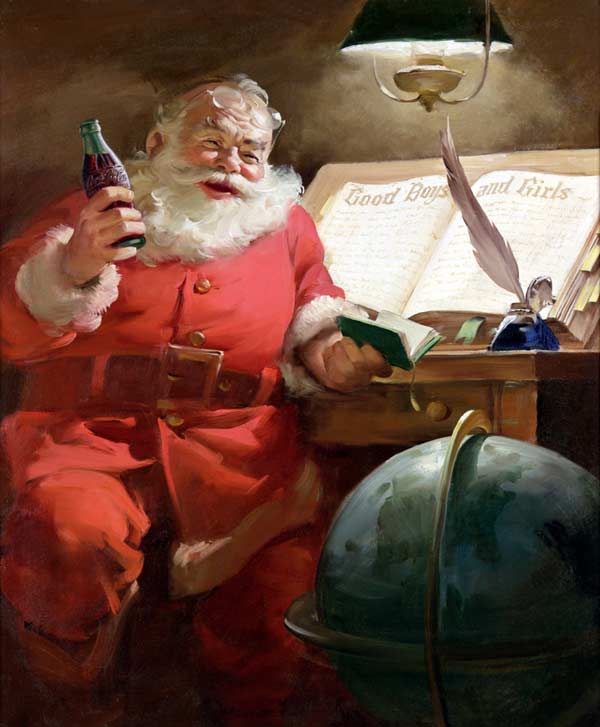
Virtuoso Voices has compiled interviewing tips from pubradio personalities Bob Edwards, Susan Stamberg, Kurt Andersen, Lisa Mullins, John Diliberto, Lynn Neary and others. It’s all in a 25-page Interviewing 3.0 pdf (296KB).
David Schulman’s (of MITOW) thots on interviewing “feng shui†are revalations. Below are some excerpts from “Interviewing Performing Artists… and Others: A Practical Guide”…
Bob Edwards (The Bob Edwards Show):
Think of it as a conversation and not an interview. If you do an interview, it will likely SOUND like an interview. How do you talk to a friend over a beer? First you LISTEN—and you react to what you’ve heard. If someone tells me something really interesting, I’ll simply say, “Really?†or “No!†Those are little words of encouragement that signal the speaker to continue—and to expand on previous remarks. If your guest is truly confusing, try “Huh?â€
Indulge yourself. Ask the question you’ve always wanted to ask. “What’s that lyric about?â€
Susan Stamberg (NPR):
Listening to answers is more important than asking the question.
Best question is often the simplest: WHY?
John Diliberto (Echoes:
Don’t be afraid to ask the hard question. They aren’t your friends and you don’t have to worry that they won’t like you or walk out. Although occasionally they do.
Don’t be afraid to ask the obvious question. I got this from listening to Terry Gross, who, besides being a probing interviewer, also knows where the good stories are and isn’t afraid to query into known terrain, because a good story is still a good story, even if it’s been heard before. Chances are, most people still don’t know it. Then find a different angle on that story.
Jake Warga takes us on a personal tour through the Holy Land, looking at how the conflict started and what it’s like today between Jerusalem and Bethlehem… between birth and re-birth. (Also a PRX radio story.):
Holy Land Tour from Jake Warga
Matt Dunne, Google’s head of community affairs, names numbers:
Each day, Google processes 2 billion searches, sends two e-mails per second through its Gmail account system, and uploads 22 hours of video onto You Tube, per minute. It would take a lifetime to watch the video posted on the site every three months.
…and what a dull, dreary lifetime that would be. More Google #s in “The ever-expanding Googleverse” Vtdigger.org.
The Story of Stuff folk have a new film out on The Story of Cap & Trade. Annie Leonard once again does her simple, straight-forward finger-pointing at job pointing to some devilish details in the current proposals:
Cap & Trade Trailer
The full film is: The Story of Cap & Trade.
HV talked with Annie in 2006.
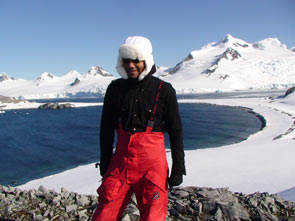 DJ Spooky That Subliminal Kid combines field-recordings and feelings he collected in the South Pole into Terra Nova: Sinfonia Antarctica, a “large scale multimedia performance work” (NPR story):
DJ Spooky That Subliminal Kid combines field-recordings and feelings he collected in the South Pole into Terra Nova: Sinfonia Antarctica, a “large scale multimedia performance work” (NPR story):
Miller’s field recordings from a portable studio, set up to capture the acoustic qualities of Antarctic ice forms, reflect a changing and even vanishing environment under duress. Coupled with historic, scientific, and geographical visual material, Terra Nova: Sinfonia Antarctica is a seventy minute performance, creating a unique and powerful moment around man’s relationship with nature.